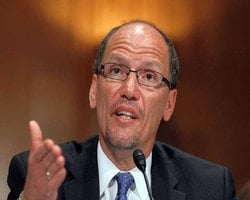The US September unemployment rate fell from 7.3% in August to 7.2% in September. A total of 148,000 jobs were added in September, less than economists had expected.
Analysts has expected the US economy to add about 180,000 jobs in September. With the US September unemployment falling more moderately than predicted, some are now wondering whether the country’s economic recovery is losing steam.
US September unemployment figures arrived late
New job figures for September arrived later in the month than usual because the partial government shutdown closed many agencies that publish economic data.
The Department of Labor warned that October job figures would not be released until November 8th as it tries to recover a backlog of work caused by the partial shutdown.
Many companies said they were affected by the government shutdown.
There were 32,000 new registered jobs for professional and business services, while hospitality and leisure employment dropped by 13,000.
Secretary of Labor Thomas E. Perez, said:
“The economy added 148,000 total nonfarm jobs in September. With the addition of 126,000 private-sector jobs, that makes a total of over 7.6 million new private-sector jobs over the last 43 consecutive months of growth. The monthly unemployment rate inched downward to 7.2 percent and has been below 8 percent for a full year, following more than three and a half years above 8 percent. Average hourly earnings rose by 3 cents in September, with a 49-cent increase over the last year.”
How the Fed may react to US September unemployment figures
The Federal Reserve said it would only consider tapering its $85 billion-per-month economic stimulus package when it saw unemployment falling steeply and steadily. In view of September’s disappointing figures, experts believe the Fed will continue pumping money into the economy for quite a while.
The BBC quoted Carl Leahey, a senior adviser at Decision Economics, who said “This report will soften people’s assessments of current conditions. With the possibility of a replay of the budget showdown as early as mid-January, why would the Fed want to pull any levers now?,”
Secretary Perez said the US economy continues on the road to recovery, but at a slower pace than the country’s people need or expect. He added that President Barack Obama is asking Congress to approve a budget that invests in key priorities, such as technology, infrastructure and education, while continuing to take measures to reduce the deficit over the long term.
Secretary Perez added:
“… and he (Obama) is stepping up the call to fix our broken immigration system in a way that increases economic growth. These job-creating initiatives should have been the nation’s focus over the last month; instead we were sidetracked by a divisive struggle that inflicted unnecessary wounds on the economy.
This report comes behind schedule, as the federal government was shut down on the first Friday of this month. It does not reflect the adverse impact of the shutdown on the national economy, something we won’t be able to fully measure until more data are released in the coming months.
But we do know that economic uncertainty was already holding back growth even before this latest standoff. The shutdown and the threat to default on our nation’s debt unquestionably set back our recovery. Employers put hiring and investment on hold. Families delayed or cut back on spending. Banks raised the cost of borrowing for homeowners and small businesses. The financial markets reacted negatively, and we lost respect in the eyes of the world. This avoidable confrontation was exactly what an economy on the mend did not need.
The economy can’t live up to its potential if it’s hijacked every few months. Businesses manufacture jobs, while Congress manufactures crises. Let’s move on to the task that Americans demand of us – working together to create jobs, grow the economy and strengthen the middle class.”
The Bureau of Labor Statistics also published the following data on private non-farm payrolls for September 2013:
- Average working week 34.5 hours (unchanged vs. August).
- Manufacturing – average working week 40.8 hours (unchanged vs. August).
- Manufacturing – average overtime 3.4 hours (unchanged vs. August).
- Average hourly earnings rose by 3 cents to $24.09.
Stock markets generally responded positively with the expectation that the Fed’s stimulus package will continue unchanged. However, the dollar came under pressure.

